

This eleven-storey building survived the German bombing of Rotterdam in World War II. It had a degree of fame as the first high rise (hoogbouw) in Europe and was Europe's tallest building for a number of years. The facade, sometimes criticized as kitsch, is faced with white glazed brick, as well as mosaic designs. Though less modern and more Dutch (with this roof and turret!), it bears comparison with Chicago's Reliance Building, built between 1894-5 by Burnham and Adler, a building faced with white terra cotta tiles and with decorative designs. View facing the waterThis is the main entrance facade. See below the distant view of the grand entrance with sculptural decoration. | ||
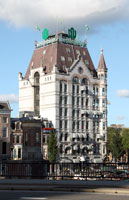 |
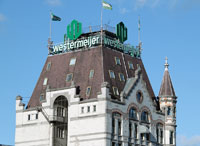 |
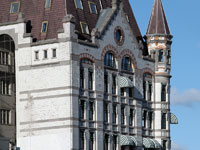 |
View facing away from the riverThe height of this building is not supported by a steel skeleton, as would later be the practice; the walls are load-bearing although iron, steel, and concrete are used in the construction and there are very thick interior walls. The building also had an elevator. |
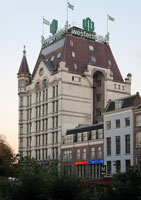 |
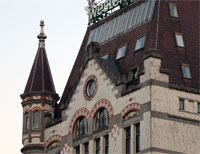 |
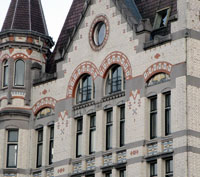 |
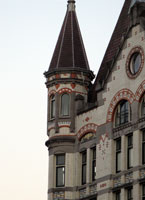 |
Decorative masonrySmall floral art nouveau paintings (?) decorate the arch above the side windows. |
| Sometimes defined as art nouveau in style, this characterization is only apparent to me in the curvilinear decoration of the lower facade. "In the niches on the first floor six statues of Simon Miedema are posted that symbolize Labour, Progress, Industry, Commerce, Agriculture and Marine. During the Battle of the Williams Bridge in May 1940, the Labour statue was destroyed by shrapnel. The Marine statue moved so an empty niche remains in the Wijnstraat" (internet website} . | ||
Left: lower level entrance facing water; center: back lower level |
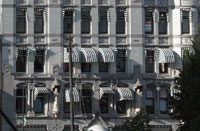 |
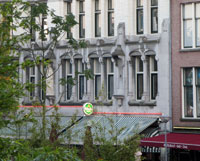 |
 Click here to return to index of art historical sites.
Click here to return to index of art historical sites.
 Click here to return to index of artists and architects.
Click here to return to index of artists and architects.
 Click here to return to chronological index.
Click here to return to chronological index.
 Click here to see the home page of Bluffton University.
Click here to see the home page of Bluffton University.
